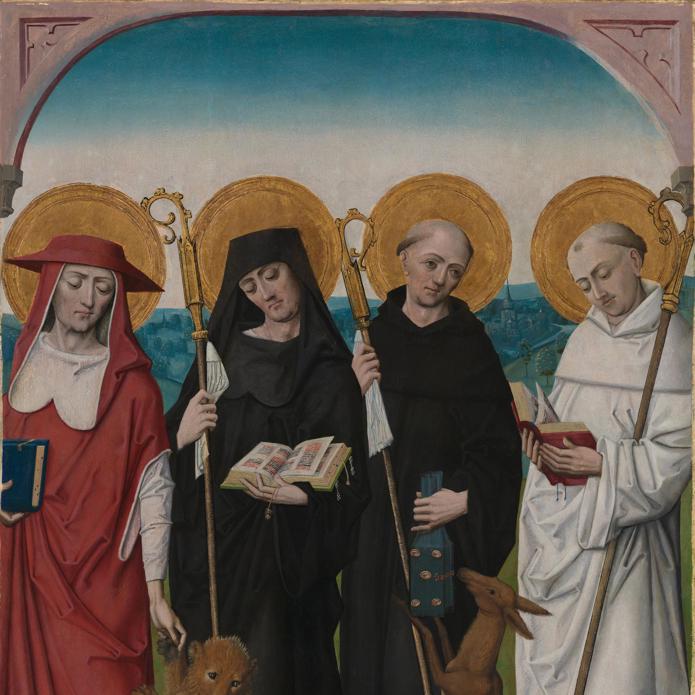Workshop of the Master of the Life of the Virgin, 'The Conversion of Saint Hubert: Left Hand Shutter', probably 1485-90
About the work
Overview
Saint Hubert kneels in prayer in front of a vision of Christ upon the Cross, which has miraculously appeared between the antlers of a stag. Hubert was a courtier in Metz, a city in the eastern Frankish Kingdom, and an enthusiastic hunter. He had been out with his dogs in the forest of Ardennes when he had this vision of the crucified Christ – a confrontation that converted him to Christianity. Hubert became Bishop of Liège in 716.
The artist has evoked Hubert’s wealth and status through his elaborate clothing – his gold damask tunic is edged with fur, and slashed to reveal his red velvet sleeve beneath. The sky is made of gold leaf and would have shimmered in the light of the candles on the altar. The painting also has an imagined internal light source: careful shadows, for example beneath Hubert’s bent right leg, suggest a crisp daylight.
Key facts
Details
- Full title
- The Conversion of Saint Hubert: Left Hand Shutter
- Artist
- Workshop of the Master of the Life of the Virgin
- Artist dates
- active second half of the 15th century
- Part of the series
- Two Shutters from the Werden Altarpiece
- Date made
- probably 1485-90
- Medium and support
- oil on wood
- Dimensions
- 123 × 83.2 cm
- Acquisition credit
- Bought, 1854
- Inventory number
- NG252
- Location
- Not on display
- Collection
- Main Collection
Provenance
Additional information
Text extracted from the ‘Provenance’ section of the catalogue entry in Susan Foister, ‘National Gallery Catalogues: The German Paintings before 1800’, London 2024; for further information, see the full catalogue entry.
Exhibition history
-
2014Strange Beauty: Masters of the German RenaissanceThe National Gallery (London)19 February 2014 - 11 May 2014
Bibliography
-
1959Levey, Michael, National Gallery Catalogues: The German Schools, London 1959
-
2001
C. Baker and T. Henry, The National Gallery: Complete Illustrated Catalogue, London 2001
-
2024S. Foister, National Gallery Catalogues: The German Paintings before 1800, 2 vols, London 2024
About this record
If you know more about this painting or have spotted an error, please contact us. Please note that exhibition histories are listed from 2009 onwards. Bibliographies may not be complete; more comprehensive information is available in the National Gallery Library.
Images
About the series: Two Shutters from the Werden Altarpiece

Overview
These paintings once formed the shutters of an altarpiece made for the Benedictine abbey at Werden, near Cologne in Germany. The shutters were decorated on both sides, and could be closed to protect the central part of the altarpiece, which has not been traced.
The inner and outer faces have been separated, creating four panels out of two. The inner faces, which would have been visible when the shutters were open, show events from the life of Saint Hubert. The outer faces each show four standing saints, including Saint Hubert and Saint Benedict, as well as other members of the Benedictine Order.





